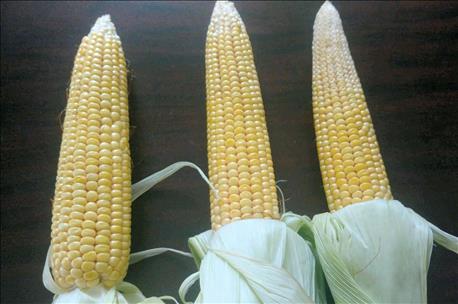August 11, 2016

I got the phone call Tuesday - you know the one you always want, but aren't sure you should accept. Marshall county extension educator Bob Yoder called and asked if I was around home. After an affirmative reply, he asked if I was willing to do an interview alongside him for one of the local TV stations. Hesitantly, I agreed. He said great, they would be at my place in about half an hour.
The interview focused on the dry weather and its impact on crops. As always, after it’s over and the dust settles, there are things you wish you had said.

These three ears of corn all had the same kernel count. The one on the left is how we would hope to find an ear. Middle ear shows signs of abnormal maturity - aborting kernels. Ear on right is what many plants will look like if we don’t get rain soon.
I think we did a good job conveying the importance of normal precipitation to the grain crops. (We should have included forages as well.) With that in mind, here is what we wanted to convey:
-The soil can only hold two, maybe three inches of rain (moisture) in the usable profile, about 1-2 ft.
-During reproductive stages, the crop uses .25-.35 inches per day. This is why we don’t get overly excited about a couple of tenths of an inch of precipitation. We prefer rain measured in inches.
-Plants are resilient. But once grain is lost during reproduction, it cannot be recovered.
-Heat may be even more damaging than lack of rain. Plants need to rest too. Nighttime temperatures above 70 degrees F prevent rest.
Visual proof
The photo with this blog is the example I showed the reporter. These three ears of corn all had the same kernel count. The one on the left is how we would hope to find an ear, full nearly to the end. As you look at the right ears, you can see some of the kernels at the tip appear to be shrinking and denting. This is not normal physical maturity. The plant has entered a survival mode of sorts. It is pulling nutrients out of the tip kernels, back down the ear toward the base in order to fill those kernels and make them viable seeds.
The ear in the middle had begun to 'tip back' or abort kernels. This is what many ears look like now. The ear on the right is a more extreme example of tip back. This is what many ears will look like soon if we don't receive rain. A forecast heatwave will add to the damage. Each row of kernels on the ear represents about 5 bushel per acre. So, if an ear from the field (which coincidentally started out near the expected USDA yield 172.8 bushels per acre) aborts only 4 kernels in length. That is a 20-bushel per acre reduction, equating to 150 bushel yield.
So, why is that important? As Bob pointed out, the farm economy isn't doing too well right now. Low prices (sub $3.50 corn and $10 soybeans) in conjunction with less than stellar yields creates dire positions for farmers. The farm economy supported the general economy during the last recession. Manufacturing jobs were added in our industry; sales and support services were expanded. Local contractors (builders, electricians, HVAC, etc.) were kept busy building pole barns, shops and other farm facilities.
A downturn in agriculture is a drain on the general economy. I saw last week that Deere announced another layoff, this time at the combine production plant. Though ag is a small sector it has a wide-reaching impact.
Now you know why we cry about rain. This is a glimpse at how agriculture is intertwined with the general economy. My comments in the blog went past the scope of the news report. However, if you want to see it, the report is posted at wndu.com. I'm sure the reporter’s boss likes seeing clicks on stories. Feel free to check it out. Bob wasn’t featured in the interview, but gave a bunch of good information and background. Thanks again Bob!
About the Author(s)
You May Also Like






